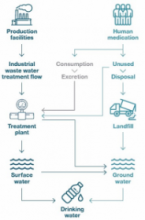Water, Water Everywhere and Not a Drop to Drink
Water is vital for drinking, crop irrigation, animal farming, industrial manufacturing and energy production, as well as cleaning and several other daily human activities.
Water is vital for drinking, crop irrigation, animal farming, industrial manufacturing and energy production, as well as cleaning and several other daily human activities.

Hotspots for the contamination of the environment and drinking water sources with hazardous compounds include areas such as industrial manufacturing, medication disposal/excretion and landfill leachate.
All activities detailed in the chart occur on a global scale and are vital in the maintenance of our modern world. For example, the ongoing production of clothing, medication, technology and many more, so these activities are only set to increase as populations grow.
Furthermore, in order to feed our existing 7.5 billion population, the agricultural sector accounts for 70% of the world’s total water consumption, compared to the 20% for industrial manufacturing and 10% for domestic use. Unfortunately, irrigation is not always conducted using the most sustainable methods.
The process of irrigation provides soil with the essential moisture that plants need to grow and the frequency and volume of water for irrigation is determined by the size and type of crop in production. The Food and Agriculture Organisation (FAO) of the United Nations describes ‘irrigation efficiency’ as the ratio of the volume of water required for irrigation over the volume of water diverted from the source of supply. This is a calculation which should be monitored carefully to assess both water consumption and loss.
To put this into perspective, it is estimated that the production of one slice of bread requires the equivalent of 40 litres of water and 100g potatoes require 25 litres. This is why it is of paramount importance that water efficiencies are closely scrutinised as freshwater is not an infinite resource and it is already under strain.